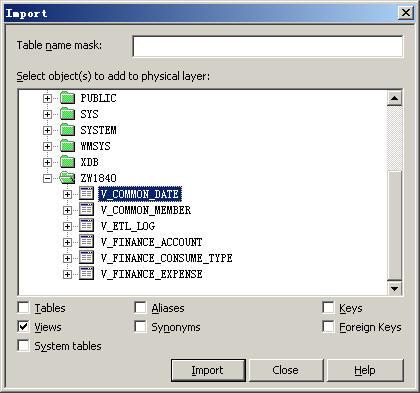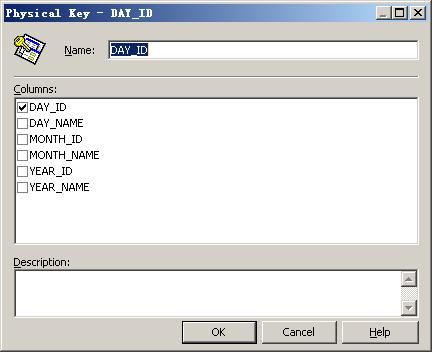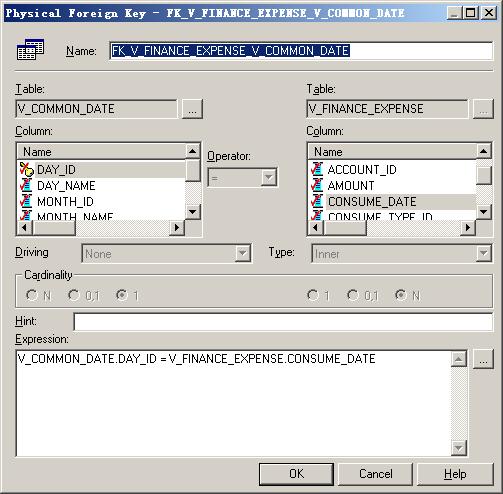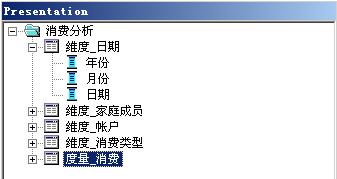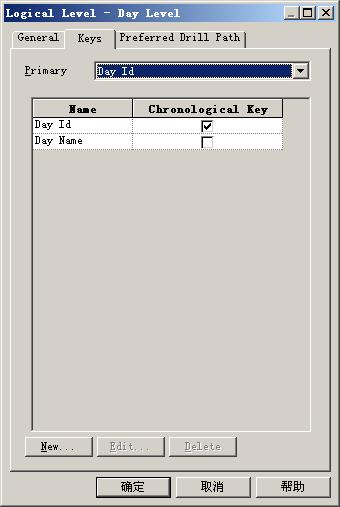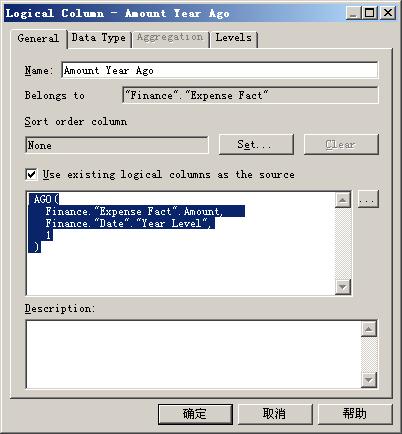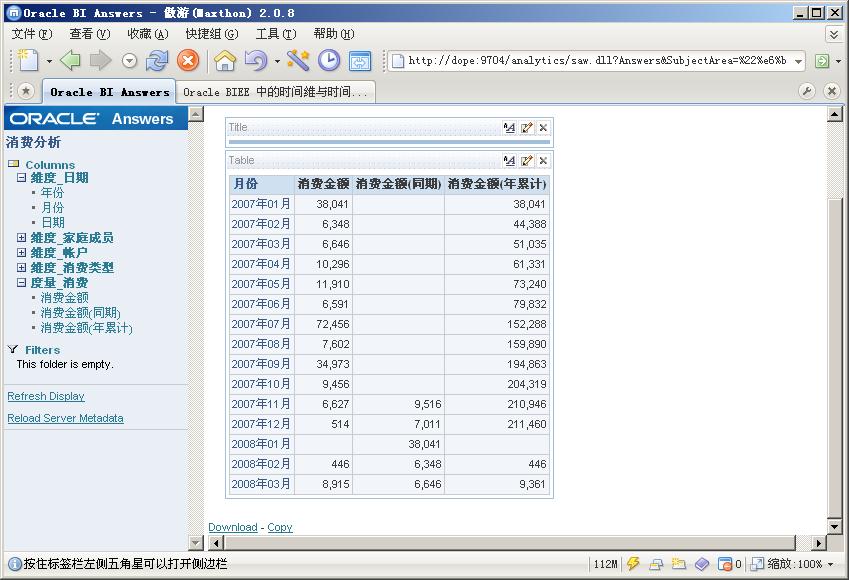累计、同比、环比是 BI 项目中常用的分析方法。
本文讲述如何利用 Oracle BIEE 的时间维(Time Dimension)及时间轴函数(Time Series Conversion Function)实现累计、同比、环比计算。
时间轴函数概述
累计、同比、环比是 BI 项目中常用的分析方法。如果采用关系型数据库,直接通过 SQL 语句进行这样的计算是比较麻烦的。Oracle BIEE 提供的解决方法是时间轴函数。时间轴函数是位于逻辑模型层内的函数,使用时间轴函数能够定义出“去年同期值”或“本年累计值”之类的与时间相关的计算字段。Oracle BIEE 现在支持两个时间轴函数:
Ago:从当前时间起回溯用户指定的 n 个时间段,返回当时的度量值。
ToDate:从用户指定时间段的起点开始,到当前时间为止,计算度量值的累计值。
使用时间轴函数的前提条件是在逻辑模型内定义了时间维。上面两个函数说明中的“时间段”实际上指的是时间维的层级(Level)。例如使用 Ago 函数定义“去年同期值”,指定的时间段为“年”这一层级,指定的回溯周期为 1,表示得到去年的值。再比如使用 ToDate 函数定义“本年累计值”,指定的时间段也是“年”这一层级,表示从年的起点(年初)开始到当前时间为止,求度量值的累计值。
创建时间维的准备工作
时间维的创建过程与创建普通维度基本相同,只是维度对象的某些设置不同。因此创建物理模型、逻辑模型、及展现模型的过程在此不细说了。
在物理模型层,导入时间维表 V_COMMON_DATE;将 V_COMMON_DATE.DAY_ID 定义为 V_COMMON_DATE 的主键;将 V_COMMON_DATE.DAY_ID 定义为 V_FINANCE_EXPENSE.CONSUME_DATE 的外键。
在逻辑模型层,将物理表“V_COMMON_DATE”拖放到逻辑模型“Finance”内;使用“Rename Wizard”重命名;将逻辑字段“Day Id”定义为逻辑表“Date Dim”的逻辑主键;在逻辑表“Date Dim”和“Expense Fact”之间创建逻辑连接。
在展现模型层,将逻辑表“Date Dim”拖放到展现模型“消费分析”内;只保留年、月、日的名称字段,并重命名。
需要注意的是,Oracle BIEE 对与时间维相关的物理表及逻辑表有以下要求:
如果某个物理表的字段被映射到了时间逻辑表上,那么这个物理表中的字段不能再映射到其他逻辑表中。
作为时间逻辑表的数据源的物理表,只允许与物理事实表关联。且关联只能基于外键(foreign key),而不能基于复杂连接(complex join)。
创建时间维
与创建普通维度对象一样,以逻辑表“Date Dim”为基础创建维度对象“Date”;依次定义层级:“Total Level”、“Year Level”、“Month Level”、“Day Level”,并设定层级的元素数;将逻辑表“Date Dim”的各列拖放当相应的层级;定义各层级的层键,并设定主层键,以及用于下钻的层键。
时间维与普通维度有两处不同。首先,双击维度“Date”节点,在“Dimension”对话框中需要选中“Time Dimension”选项,以表明此维度对象为时间维度。
其次,时间维度中需要定义时间序列键(Chronological Key)。时间序列键的作用是表明时间维中具有一组单调增加的时间序列值。
定义时间序列 时存在以下原则:
时间维中,至少一个层级上应定义有时间序列键。
物理存储的最细时间粒度上必须定义时间序列键。在例子中,物理表“V_FINANCE_EXPENSEE”的日期字段“CONSUME_DATE”为日期,即 物理存储的最细时间粒度为日期,因此时间维“Date”的“Day Level”上应该定义时间序列键。
在这个简单的例子中,我只把层级“Day Level”的逻辑层键“Day Id”定义为时间序列键。
使用时间轴函数定义度量值
定义好时间维后,就可以在逻辑事实表中定义使用时间轴函数的逻辑列了。在逻辑表“Expense Fact”上单击右键,选择“New Object\Logical Column”创建逻辑列。在“Logical Column”对话框中选择“Use existing logical columns as source”再按右侧的按钮,可以打开“Expression Builder”编辑逻辑列的公式。最后不要忘记将逻辑列添加到展现模型中。
例如,使用 Ago 函数定义“去年同期值”。
AGO(Finance."Expense Fact".Amount, Finance."Date"."Year Level", 1)
第一个参数是逻辑字段 Finance."Expense Fact".Amount,是用于时间轴运算的度量值;第二个参数是逻辑模型时间维的层级 Finance."Date"."Year Level",表明回溯的时间单位为年;第三个参数表示回溯的时间周期,1 则为回溯一年,即去年。
再例如,使用 ToDate 函数定义“本年累计值”。
TODATE(Finance."Expense Fact".Amount, Finance."Date"."Year Level")
第一个参数是逻辑字段 Finance."Expense Fact".Amount,是用于时间轴运算的度量值;第二个参数是逻辑模型时间维的层级 Finance."Date"."Year Level",表明累计计算开始自年时间的起点,终止到当前时间。
在进行时间查询时应注意几个重要的粒度[7],以查询 select "Date Dim"."Month Name", "Expense Fact"."Amount Year Ago" 为例:
"Date Dim"."Month Name" 为查询粒度。
"Expense Fact"."Amount Year Ago" 逻辑列对应的时间维层级为时间序列粒度。
在包含时间序列函数的查询中,时间序列粒度必须大于等于查询粒度。
"Expense Fact"."Amount Year Ago" 逻辑列对应的物理表的时间粒度被称为存储粒度。
与存储粒度对应的时间维层级上必须定义时间序列键。
Ago 与 ToDate 函数可以嵌套调用,但需要遵守一定规则[8]。
在使用时间序列函数时也有一定限制,具体请参考 BIEE 文档[9]。
查询
定义如下查询,其中“消费金额(同期)”与“消费金额(年累计)”分别为使用 Ago 和 ToDate 函数创建的逻辑列:
结果如下图所示:
参考
[1] Server Administration Guide p197
This identifies the dimension as having a monotonically increasing value in time (corresponds to chronological order).
[2] Server Administration Guide p130
At least one level of a time dimension must have a chronological key.
[3] Server Administration Guide p197
The chronological key has to be defined at this level. (storage grain level)
[4] Server Administration Guide p197
It is recommended that you define additional chronological keys at other relevant levels for performance reasons.
我估计其他层级的时间序列键在聚合导航(Aggregate Navigation)时会被用到。
[5] Server Administration Guide p130
For any level, you can select one or more chronological keys and then sort keys in the level, however, only the first chronological key is used at this time.
[6] Server Administration Guide p127
Any physical table that is part of a time logical table cannot appear in another logical table. This prevents using date fields from calendar table as measures.
Physical tables in time sources, except the most detailed ones, cannot have joins to table outside their source. The join has to be between the time table and the fact table. The join can only be based on foreign key; it cannot be a complex join.
[7] Server Administration Guide p197
The following list describes the important grains in navigating a time query
[8] Server Administration Guide p198-199
p198 Multiple Ago functions can be nested if all the Ago functions have the same level argument.
p198 NOTE: You can nest exactly one ToDate and multiple Ago functions if they each have the same level argument.
p199 A ToDate function may not be nested within another ToDate function.
[9] Server Administration Guide p127
All time series measures using the Ago and ToDate functions must be on time levels. Ago and ToDate aggregates are created as derived logical columns.
Ago or ToDate functionality is not supported on fragmented logical table sources.
文章源自
本文讲述如何利用 Oracle BIEE 的时间维(Time Dimension)及时间轴函数(Time Series Conversion Function)实现累计、同比、环比计算。
时间轴函数概述
累计、同比、环比是 BI 项目中常用的分析方法。如果采用关系型数据库,直接通过 SQL 语句进行这样的计算是比较麻烦的。Oracle BIEE 提供的解决方法是时间轴函数。时间轴函数是位于逻辑模型层内的函数,使用时间轴函数能够定义出“去年同期值”或“本年累计值”之类的与时间相关的计算字段。Oracle BIEE 现在支持两个时间轴函数:
Ago:从当前时间起回溯用户指定的 n 个时间段,返回当时的度量值。
ToDate:从用户指定时间段的起点开始,到当前时间为止,计算度量值的累计值。
使用时间轴函数的前提条件是在逻辑模型内定义了时间维。上面两个函数说明中的“时间段”实际上指的是时间维的层级(Level)。例如使用 Ago 函数定义“去年同期值”,指定的时间段为“年”这一层级,指定的回溯周期为 1,表示得到去年的值。再比如使用 ToDate 函数定义“本年累计值”,指定的时间段也是“年”这一层级,表示从年的起点(年初)开始到当前时间为止,求度量值的累计值。
创建时间维的准备工作
时间维的创建过程与创建普通维度基本相同,只是维度对象的某些设置不同。因此创建物理模型、逻辑模型、及展现模型的过程在此不细说了。
在物理模型层,导入时间维表 V_COMMON_DATE;将 V_COMMON_DATE.DAY_ID 定义为 V_COMMON_DATE 的主键;将 V_COMMON_DATE.DAY_ID 定义为 V_FINANCE_EXPENSE.CONSUME_DATE 的外键。
在逻辑模型层,将物理表“V_COMMON_DATE”拖放到逻辑模型“Finance”内;使用“Rename Wizard”重命名;将逻辑字段“Day Id”定义为逻辑表“Date Dim”的逻辑主键;在逻辑表“Date Dim”和“Expense Fact”之间创建逻辑连接。
在展现模型层,将逻辑表“Date Dim”拖放到展现模型“消费分析”内;只保留年、月、日的名称字段,并重命名。
需要注意的是,Oracle BIEE 对与时间维相关的物理表及逻辑表有以下要求:
如果某个物理表的字段被映射到了时间逻辑表上,那么这个物理表中的字段不能再映射到其他逻辑表中。
作为时间逻辑表的数据源的物理表,只允许与物理事实表关联。且关联只能基于外键(foreign key),而不能基于复杂连接(complex join)。
创建时间维
与创建普通维度对象一样,以逻辑表“Date Dim”为基础创建维度对象“Date”;依次定义层级:“Total Level”、“Year Level”、“Month Level”、“Day Level”,并设定层级的元素数;将逻辑表“Date Dim”的各列拖放当相应的层级;定义各层级的层键,并设定主层键,以及用于下钻的层键。
时间维与普通维度有两处不同。首先,双击维度“Date”节点,在“Dimension”对话框中需要选中“Time Dimension”选项,以表明此维度对象为时间维度。
其次,时间维度中需要定义时间序列键(Chronological Key)。时间序列键的作用是表明时间维中具有一组单调增加的时间序列值。
定义时间序列 时存在以下原则:
时间维中,至少一个层级上应定义有时间序列键。
物理存储的最细时间粒度上必须定义时间序列键。在例子中,物理表“V_FINANCE_EXPENSEE”的日期字段“CONSUME_DATE”为日期,即 物理存储的最细时间粒度为日期,因此时间维“Date”的“Day Level”上应该定义时间序列键。
- 除了必要的时间序列键,时间维的各个层级上均可建立额外的时间序列键,这主要是为提高查询性能服务。
- 时间维的同一层级上可以建立多个时间序列键,但只有第一个时间序列键有效。
在这个简单的例子中,我只把层级“Day Level”的逻辑层键“Day Id”定义为时间序列键。
使用时间轴函数定义度量值
定义好时间维后,就可以在逻辑事实表中定义使用时间轴函数的逻辑列了。在逻辑表“Expense Fact”上单击右键,选择“New Object\Logical Column”创建逻辑列。在“Logical Column”对话框中选择“Use existing logical columns as source”再按右侧的按钮,可以打开“Expression Builder”编辑逻辑列的公式。最后不要忘记将逻辑列添加到展现模型中。
例如,使用 Ago 函数定义“去年同期值”。
AGO(Finance."Expense Fact".Amount, Finance."Date"."Year Level", 1)
第一个参数是逻辑字段 Finance."Expense Fact".Amount,是用于时间轴运算的度量值;第二个参数是逻辑模型时间维的层级 Finance."Date"."Year Level",表明回溯的时间单位为年;第三个参数表示回溯的时间周期,1 则为回溯一年,即去年。
再例如,使用 ToDate 函数定义“本年累计值”。
TODATE(Finance."Expense Fact".Amount, Finance."Date"."Year Level")
第一个参数是逻辑字段 Finance."Expense Fact".Amount,是用于时间轴运算的度量值;第二个参数是逻辑模型时间维的层级 Finance."Date"."Year Level",表明累计计算开始自年时间的起点,终止到当前时间。
在进行时间查询时应注意几个重要的粒度[7],以查询 select "Date Dim"."Month Name", "Expense Fact"."Amount Year Ago" 为例:
"Date Dim"."Month Name" 为查询粒度。
"Expense Fact"."Amount Year Ago" 逻辑列对应的时间维层级为时间序列粒度。
在包含时间序列函数的查询中,时间序列粒度必须大于等于查询粒度。
"Expense Fact"."Amount Year Ago" 逻辑列对应的物理表的时间粒度被称为存储粒度。
与存储粒度对应的时间维层级上必须定义时间序列键。
Ago 与 ToDate 函数可以嵌套调用,但需要遵守一定规则[8]。
在使用时间序列函数时也有一定限制,具体请参考 BIEE 文档[9]。
查询
定义如下查询,其中“消费金额(同期)”与“消费金额(年累计)”分别为使用 Ago 和 ToDate 函数创建的逻辑列:
结果如下图所示:
参考
[1] Server Administration Guide p197
This identifies the dimension as having a monotonically increasing value in time (corresponds to chronological order).
[2] Server Administration Guide p130
At least one level of a time dimension must have a chronological key.
[3] Server Administration Guide p197
The chronological key has to be defined at this level. (storage grain level)
[4] Server Administration Guide p197
It is recommended that you define additional chronological keys at other relevant levels for performance reasons.
我估计其他层级的时间序列键在聚合导航(Aggregate Navigation)时会被用到。
[5] Server Administration Guide p130
For any level, you can select one or more chronological keys and then sort keys in the level, however, only the first chronological key is used at this time.
[6] Server Administration Guide p127
Any physical table that is part of a time logical table cannot appear in another logical table. This prevents using date fields from calendar table as measures.
Physical tables in time sources, except the most detailed ones, cannot have joins to table outside their source. The join has to be between the time table and the fact table. The join can only be based on foreign key; it cannot be a complex join.
[7] Server Administration Guide p197
The following list describes the important grains in navigating a time query
[8] Server Administration Guide p198-199
p198 Multiple Ago functions can be nested if all the Ago functions have the same level argument.
p198 NOTE: You can nest exactly one ToDate and multiple Ago functions if they each have the same level argument.
p199 A ToDate function may not be nested within another ToDate function.
[9] Server Administration Guide p127
All time series measures using the Ago and ToDate functions must be on time levels. Ago and ToDate aggregates are created as derived logical columns.
Ago or ToDate functionality is not supported on fragmented logical table sources.
文章源自
本站文章版权归原作者及原出处所有 。内容为作者个人观点, 并不代表本站赞同其观点和对其真实性负责。本站是一个个人学习交流的平台,并不用于任何商业目的,如果有任何问题,请及时联系我们,我们将根据著作权人的要求,立即更正或者删除有关内容。本站拥有对此声明的最终解释权。
